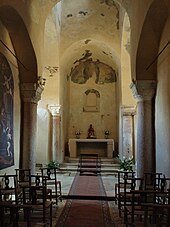San Zeno (Bardolino)
The church of San Zeno in Bardolino was probably built in the eighth century, and was first mentioned in a document in 807. It is named after the holy Zenon of Verona . The church is one of the few examples of Carolingian architecture in northern Italy and has been almost completely preserved in its original form. It was abandoned in the 13th century. In the 17th century, the exterior was changed only slightly, and there were additional residential extensions.
Structure and overall impression of the building
The structure consists of a steep room above a Latin cross with barrel vaults in the main and transepts. The groin vault of the crossing is much higher , so that one can speak of a crossing tower , which is also clearly visible on the outside and has a small bell bearer. A striving for ancient monumentality is clearly recognizable: Nothing can be felt of the character of the dark intimacy of the Longobard crypt that emerged just a few decades earlier or the atmosphere of the compact, broad Lombard church.
columns
Inside, in front of the longitudinal walls of the ship, two arched arcades - structurally functionless, only serving the architectural design - are placed on columns made of red marble, over which the wall is bricked up, so that a double-shell wall structure results. The two eastern corners of the crossing also occupy similar columns, which here support the wall corners of the crossing tower shaft. The capitals in the nave are rough Carolingian works based on ancient Corinthian and Ionic models, the south-eastern crossing capital is a fragment of an ancient original from the second century BC. BC, the northeast counterpart is a copy of such a piece.
Remnants of the painting
Both transept arms have an apse niche sunk into the east wall with fragmentarily preserved frescoes (“Mother of God with Child and St. Peter”), and on other walls and the crossing vault remains of the painting that once encompassed the entire room have been preserved.
Historical background
When the Frankish King Charles , later called the Great, overthrew the Lombard Empire , he installed his son Pippin as King of Italy and had him reside in Verona . The gigantic Benedictine Abbey of San Zeno was built at the gates of Verona , once a fortified monastery town, the favorite stay of the German kings during their procession to Rome for the imperial coronation; King Pippin and the Veronese Bishop Ratoldo transferred numerous possessions to this abbey in a document from the year 807, including the church of the same name in Bardolino. This building documents a return to antiquity, which has gone down in history under the name Carolingian Renaissance . The art-political-ideological program of the Franconian kings claiming the succession of the Roman empire is shown in the capitals of the six huge pillars flanking the nave, which are actually functionless. They mainly carry the capitals, which - far from ancient perfection - represent an attempt to recreate ancient forms.
swell
- Klaus Zimmermanns: The Veneto. Verona - Vicenza - Padua. Art, culture and landscape of Veneto . Cologne 1990. (DuMont art travel guide)
- Nana Claudia Nenzel: Tuscany , "Dumont Travel correctly", ISBN 3-7701-5598-X
- Information board at the church
Web links
Coordinates: 45 ° 32 '53.6 " N , 10 ° 43' 31.53" O





